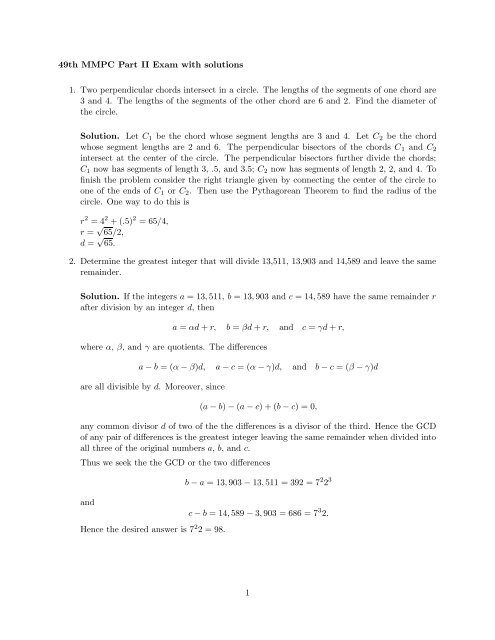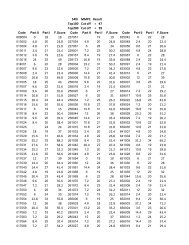49th MMPC Part II Exam with solutions 1. Two perpendicular chords ...
49th MMPC Part II Exam with solutions 1. Two perpendicular chords ...
49th MMPC Part II Exam with solutions 1. Two perpendicular chords ...
You also want an ePaper? Increase the reach of your titles
YUMPU automatically turns print PDFs into web optimized ePapers that Google loves.
<strong>49th</strong> <strong>MMPC</strong> <strong>Part</strong> <strong>II</strong> <strong>Exam</strong> <strong>with</strong> <strong>solutions</strong><br />
<strong>1.</strong> <strong>Two</strong> <strong>perpendicular</strong> <strong>chords</strong> intersect in a circle. The lengths of the segments of one chord are<br />
3 and 4. The lengths of the segments of the other chord are 6 and 2. Find the diameter of<br />
the circle.<br />
Solution. Let C1 be the chord whose segment lengths are 3 and 4. Let C2 be the chord<br />
whose segment lengths are 2 and 6. The <strong>perpendicular</strong> bisectors of the <strong>chords</strong> C1 and C2<br />
intersect at the center of the circle. The <strong>perpendicular</strong> bisectors further divide the <strong>chords</strong>;<br />
C1 now has segments of length 3, .5, and 3.5; C2 now has segments of length 2, 2, and 4. To<br />
finish the problem consider the right triangle given by connecting the center of the circle to<br />
one of the ends of C1 or C2. Then use the Pythagorean Theorem to find the radius of the<br />
circle. One way to do this is<br />
r 2 = 4 2 + (.5) 2 = 65/4,<br />
r = √ 65/2,<br />
d = √ 65.<br />
2. Determine the greatest integer that will divide 13,511, 13,903 and 14,589 and leave the same<br />
remainder.<br />
Solution. If the integers a = 13, 511, b = 13, 903 and c = 14, 589 have the same remainder r<br />
after division by an integer d, then<br />
a = αd + r, b = βd + r, and c = γd + r,<br />
where α, β, and γ are quotients. The differences<br />
a − b = (α − β)d, a − c = (α − γ)d, and b − c = (β − γ)d<br />
are all divisible by d. Moreover, since<br />
(a − b) − (a − c) + (b − c) = 0,<br />
any common divisor d of two of the the differences is a divisor of the third. Hence the GCD<br />
of any pair of differences is the greatest integer leaving the same remainder when divided into<br />
all three of the original numbers a, b, and c.<br />
Thus we seek the the GCD or the two differences<br />
and<br />
Hence the desired answer is 7 2 2 = 98.<br />
b − a = 13, 903 − 13, 511 = 392 = 7 2 2 3<br />
c − b = 14, 589 − 3, 903 = 686 = 7 3 2.<br />
1
3. Suppose A, B and C are the angles of the triangle. Show that<br />
cos 2 A + cos 2 B + cos 2 C + 2 cos A cos B cos C = <strong>1.</strong><br />
Solution: Since A = π − (B + C), cos A = − cos(B + C) = sin B sin C − cos B cos C.<br />
Therefore,<br />
LHS = (cos A + cos B cos C) 2 + cos 2 B + cos 2 C − (cos B cos C) 2<br />
= (sin B sin C) 2 + cos 2 B (1 − cos 2 C) + cos 2 C<br />
= (sin B sin C) 2 + cos 2 B (1 − cos 2 C) + cos 2 C − 1 + 1<br />
= (sin B sin C) 2 − (1 − cos 2 C)(1 − cos 2 B) + 1<br />
= (sin B sin C) 2 − (sin B sin C) 2 + 1<br />
= <strong>1.</strong><br />
4. Given the linear fractional transformation f1(x) =<br />
It can be shown that f35 = f5.<br />
2x − 1<br />
. Define<br />
x + 1<br />
fn+1(x) = f1(fn(x)) for n = 1, 2, 3, . . . .<br />
(a) Find a function g such that f1(g(x)) = g(f1(x)) = x.<br />
(b) Find f28.<br />
Solution.(Sketch.) (a) g(x) = (x + 1)/(2 − x). (b) By part (a) we see that g is the inverse<br />
of f. It can be shown that f30(x) = x by applying g five times to both sides of the functional<br />
equation f35 = f5. Thus f28 = g2 where we define g2(x) = g(g(x)). A calculation shows that<br />
g2(x) = 1/(1 − x).<br />
5. Suppose a is a complex number such that a 10 + a 5 + 1 = 0.<br />
Determine the value of a 2005 + 1<br />
a 2005 .<br />
Solution. Multiplying a 10 + a 5 + 1 = 0 by a 5 gives a 15 + a 10 + a 5 = 0. Subtracting<br />
a 10 + a 5 + 1 = 0 from a 15 + a 10 + a 5 = 0, we obtain a 15 = <strong>1.</strong> Since a = 0, dividing<br />
a 10 +a 5 +1 = 0 by a 5 yields a 5 + 1<br />
a5 = −<strong>1.</strong> Squaring the last equation leads to a10 + 1<br />
a10 = −<strong>1.</strong><br />
Now, a 2005 + 1<br />
a 2005 = (a 15 ) 133 a 10 + 1<br />
(a 15 ) 133 a 10 = a 10 + 1<br />
a 10 = −<strong>1.</strong><br />
2



